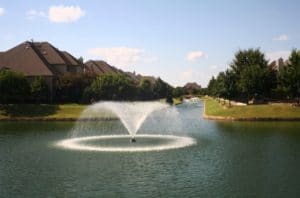During Texas heat waves, ponds are often riding a fine line between having just enough oxygen and having oxygen levels below the critical threshold for fish survival. Many environmental factors influence which side of the line the pond will fall. These include degree of sunlight, water clarity, and even time of day.

Dead bluegill due to cloudy, summertime weather
Low sunshine = low oxygen levels
Under normal summer conditions in North Texas, we have plenty of sunlight penetrating into the water. Direct sunlight allows phytoplankton and aquatic plants to produce oxygen through photosynthesis. However, several cloudy days in a row combined with extreme heat causes the oxygen level to dip close to the critical level for fish survival. Dissolved oxygen levels also fluctuate on a daily basis. Oxygen levels are highest in late afternoon after several hours of direct sunlight. During the nighttime hours, photosynthesis changes over to respiration (oxygen uptake). Therefore, dissolved oxygen levels are lowest at dawn. It only takes a few minutes below the survival threshold to have an impact on fish populations.
Aeration can help
Poorly managed ponds with excessive algae or aquatic weed growth have the most significant 24 hour dissolved oxygen fluctuations. In fact, severe infestations can cause fish kills even when no other factors are involved. There are several ways to reduce the risks. These include being mindful of weather conditions when treating for algae and aquatic vegetation, increasing dissolved oxygen through supplemental aeration, and periodically harvesting fish to avoid overpopulation.

Surface aeration enhances water quality and reduces the likelihood of a fish kill
